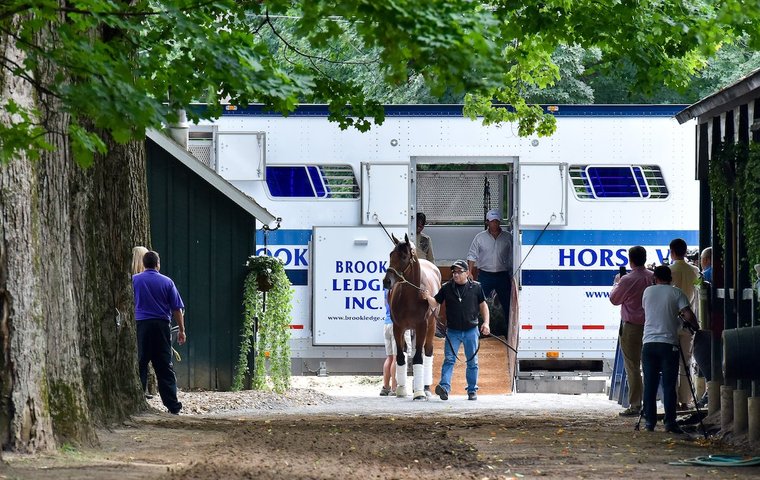
With Brook Ledge Horse Transportation, racehorses going across the continent travel in what is essentially a barn on wheels. Ken Snyder learns about how horses are shipped thousands of miles from Florida, New York and Kentucky to California – and usually arrive fresh as a daisy
In 1816 the racehorse Sovereign traveled by horse-drawn trailer 40 miles in one day to Newmarket. Today in 40 hours a horse can go from Gulfstream Park in South Florida to Santa Anita Park in Los Angeles in an over-the-road tractor-trailer, a journey that is just a few miles past 2,700.
Things have progressed dramatically over a couple of centuries – but they have also changed notably more recently. “Up to several years ago, that would have been a four- to five-day process with layovers,” explained Gulfstream Park-based Eoin Harty, who has been on the receiving end of transcontinental horse shipments at both that Florida track and Santa Anita.
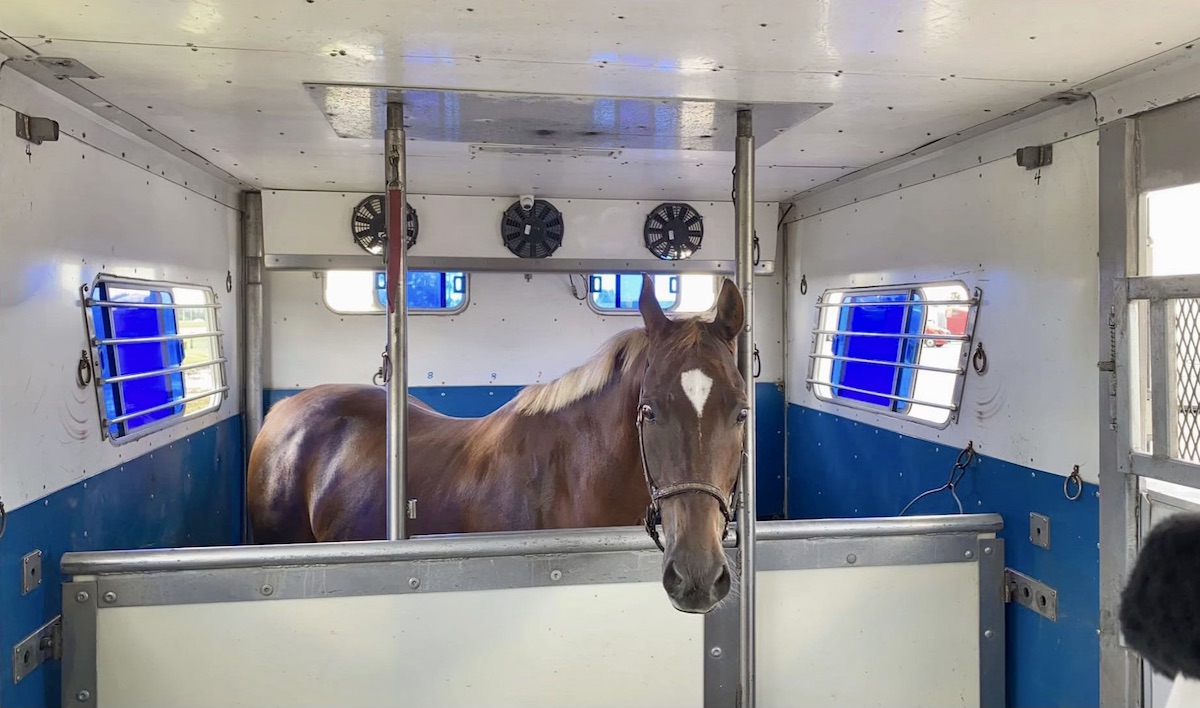 How times have changed. Now it’s non-stop – and just like air travel for humans, non-stop journeys are preferable to faffing about with layovers and separate ‘legs’ when it comes to equine travel.
How times have changed. Now it’s non-stop – and just like air travel for humans, non-stop journeys are preferable to faffing about with layovers and separate ‘legs’ when it comes to equine travel.
In fact, non-stop is all about the literal leg – as well as the rest of the horse – in trans-continental travel, as Scarlette Gotwals of Brook Ledge Horse Transportation explained.
Scarlette is the wife of company founder Bill Gotwals, whose family began shipping horses in 1974. She stressed that long-distance equine travel aims to provide all the comforts of home with maximized safety. “It’s a barn on wheels,” she said.
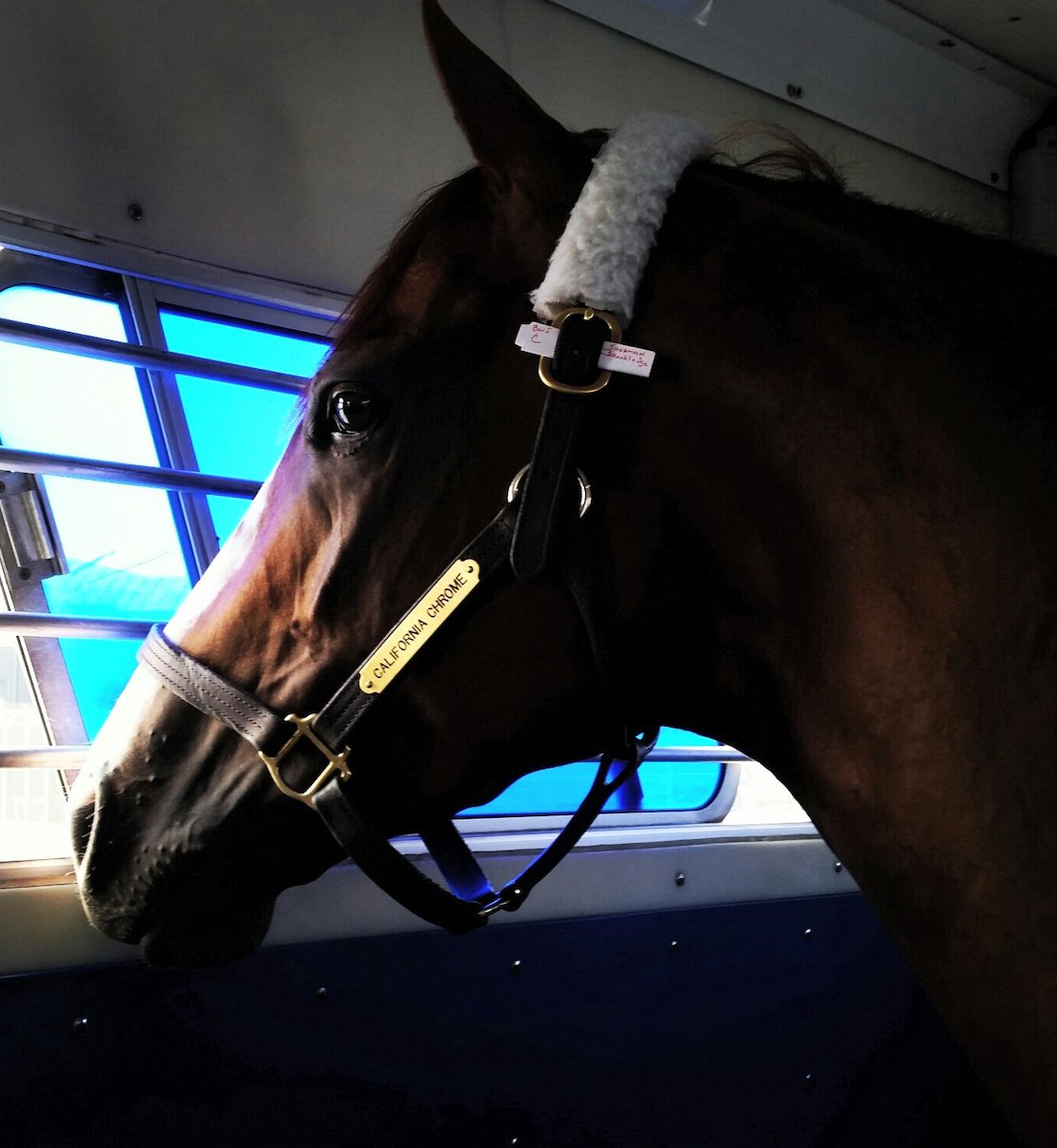 The reason is ‘box stalls’ eight-feet wide, six-feet deep, and ten-feet corner to corner. They are big enough for a horse to turn around and lay down, and airier than typical barn stalls with front, back, and side ventilation.
The reason is ‘box stalls’ eight-feet wide, six-feet deep, and ten-feet corner to corner. They are big enough for a horse to turn around and lay down, and airier than typical barn stalls with front, back, and side ventilation.
Constantly changing scenery
There’s also a bonus for the horses: constantly changing scenery. “They have a window on both sides of the trailer,” said Gotwals. “The horses will look out one window and then go over to the other side. It’s pretty funny to watch – they are really stretching their legs the entire trip.”
Such movement provides something important to condition upon arrival after a 40-hour journey; it is key to virtually eliminating any recovery post-transport.
Given that horses are inclined to stand throughout the trip, the size of the box stalls is important. They’re not so big that a sudden stop might throw a horse to the floor; instead a stall wall will keep the horse upright.
The company’s largest tractor-trailer is 53 feet, accommodating eight box stalls. On the other hand, the Brook Ledge fleet also includes smaller trailers down to two-horse trailers for local transport in and around, say, Lexington, Kentucky.
No matter the number of horses shipped, or trailer utilized, the company uses box stalls for the horses on any trip over 1,200 miles – which, of course, includes the carrier’s weekly transcontinental run. “We won’t transport a horse in a manner or method that we don’t feel is safe,” said Gotwals. Box stalls provide that safety.
The importance of box stalls became apparent around 2008, back in the days of four- to five-day transport limited to ten- to 11 hours’ travel per day and necessitating overnight layovers.
While trainers would usually put stakes horses in box stalls, less exalted companions would be in ‘stalls-and-a-half’ or ‘tie stalls’ 44 inches wide. However, trainers started noticing that the stakes horses riding in box stalls were ready to train the next day after arrival, even after multiple days of travel, while the other horses in smaller stalls needed three- to five-days’ rest.
Every horse is ready to go
When Brook Ledge tested non-stop travel cross-country in box stalls the results were conclusive: every horse was ready to go the day after arrival.
Non-stop travel also tapped into common sense for horsemen and horsewomen with layover trips. “The most dangerous point in transport is loading and unloading on trailers,” said Brook Ledge marketing manager Andrea Gotwals, Bill and Scareltte’s daughter.
“People will say, ‘We take them off and put them up every single night,’” she went on “That is not something you want to do all the time.”
Non-stops, by necessity, are not literally non-stop as drivers – two on every transcontinental trip switch off every three to five hours for fuel, hay and water replenishment, and inspection of the horses. “That’s all the stopping we do,” explained Gotwals.
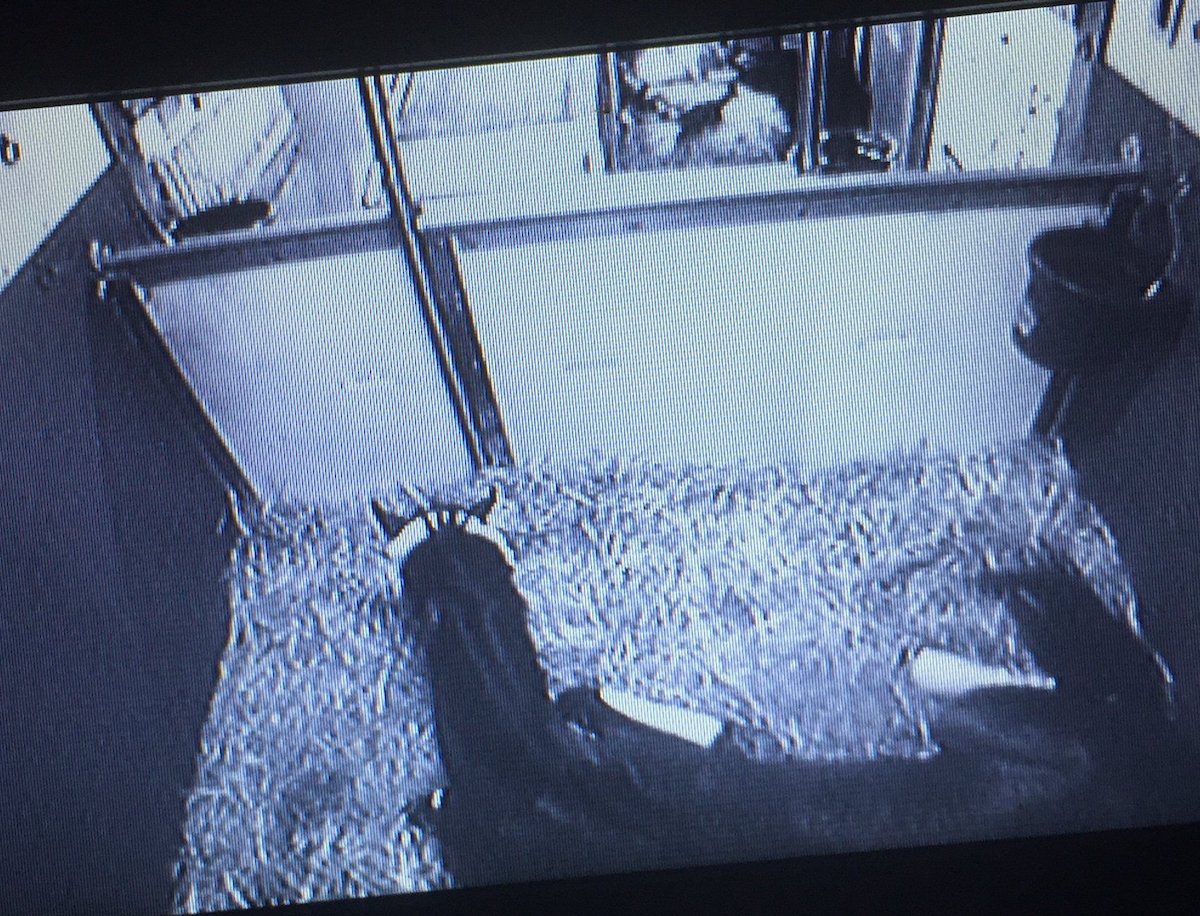 With cameras installed in every box stall, the equine passengers can be monitored around the clock vis screens in the cab of the tractor. A monitor rotates through every stall or can show all eight stalls at one time to see if there is an issue with any of the horses.
With cameras installed in every box stall, the equine passengers can be monitored around the clock vis screens in the cab of the tractor. A monitor rotates through every stall or can show all eight stalls at one time to see if there is an issue with any of the horses.
Surprise addition
Gotwals recalled one such ‘issue’ that was especially unusual, resulting in a surprise addition to the travelling party. “A mare had laid down in the stall and when they stopped for feed and water, there was a foal,” said Gotwals.
The drivers, hired for experience with horses as much as driving skills, checked everything out. “We called the owners, we sent pictures, we determined the foal was absolutely fine, and the mare was perfectly fine, so they continued on their way,” recalled Gotwals.
Indeed, the only conundrum was trying to identify in which state the horse was foaled for Jockey Club registration purposes – quite important, as it could determine where the horse might run for state-bred bonuses. The best the drivers could do was make an educated guess!
So how do horses take to a 40-hour road trip? Unless the load is from only a single trainer at a racetrack or a single farm, then the horses on board are not familiar with each other at the start of their trip. But by the end, they’re all friends, nickering and whinnying for each other, especially as they reach a destination and realize they’ll each go separate ways, according to Gotwals. As herd animals, being in company and the ability to see each other above stall walls helps them stay calm and make acquaintances with their neighbors.
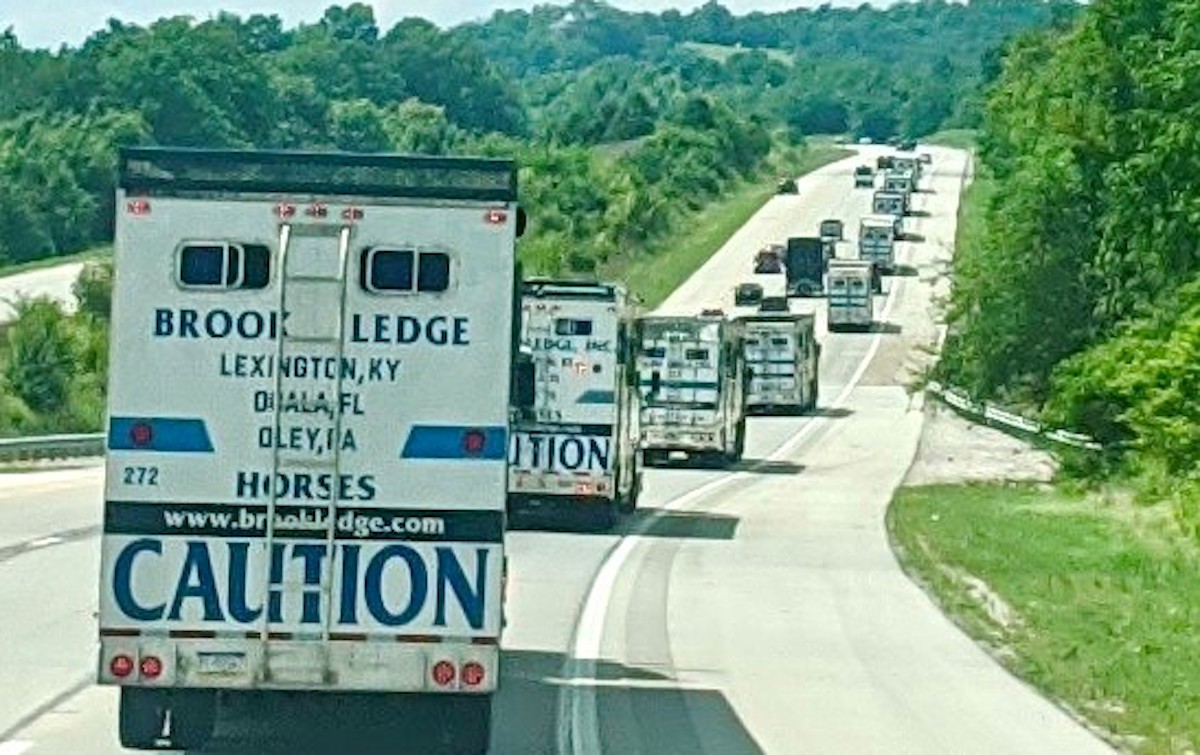 Indeed, if a certain horse is known to be a bit fractious, in a bid to keep them calm during travel trainers and farm owners will sometimes bring young horses – weanlings and yearlings – along for the ride in box stalls if they know they are paddock buddies or stall neighbors.
Indeed, if a certain horse is known to be a bit fractious, in a bid to keep them calm during travel trainers and farm owners will sometimes bring young horses – weanlings and yearlings – along for the ride in box stalls if they know they are paddock buddies or stall neighbors.
Food and drink for horses aren’t equal to airline fare (perhaps?) but they surpass first-class in availability and service. It’s a ‘free-choice’ service, meaning there’s always hay and water available. As a precaution to prevent colic, the diet is hay only and no grain; horses with allergies also get hay allergen-free.
High standard of care
The standard of care provided on board is actually better than that provided in many racetrack barns. Standard practice sees hay provided on the floor of box stalls rather than tied up at head height like you would see outside stalls at most racetracks.
This requires a horse to put its head down to feed on the trailer, which enables the microcilia in their lungs and respiratory tract to clear debris and prevent disorders, according to Scarlette Gotwals, who is a veterinarian.
Timing itself, even on a trip as long as forty 40 is meticulous. On a trip from Florida to California, for instance, departure times put the tractor-trailer in the desert at night, while arrival schedules also work around racetrack training times.
“We want horses to arrive when they don’t have to sit on the trailer at the track – they can go right in for unloading,” said Gotwals. “For example, if you arrive at the Fair Grounds [in New Orleans] and you arrive after 5am, you can’t get unloaded till after 10am.” The same kind of strategic arrival time applies to transcontinental trips.
Several factors are unique to Brook Ledge in horse transport, the first being their two hubs – one in Ocala, Florida, and another in Lexington – which provide points for gathering horses from multiple farms or racetracks for shipment on the large trailers.
Brook Ledge is also the only carrier with their own backup services and tractors in case of travel delays; the carrier has set routes with repair stations spaced four hours apart with a backup tractor on hand in the event of a breakdown of a tractor-trailer on the move with horses.
Never more than four hours away
“We have a tractor parked at a repair place with towing services,” said Gotwals. If there is a mechanical problem, then a backup tractor will be dispatched along with a tow truck to bring the first tractor back for repairs. “Horses are never more than four hours from a tractor if there is a breakdown,” added Gotwals.
While the company transports all breeds of horses, Thoroughbreds account for 80% of their business with the balance primarily going to show horses, Quarter Horses, etc. (That said, just recently Brook Ledge shipped a barnyard of goats, pigs, cows and chickens in one trailer for one client.) All told, they ship approximately 36,000 animals per year.
When it comes to hiring drivers, a candidate’s experience with horses weighs equally with behind-the-wheel experience, particularly for long-hauls. “We have horsemen as our drivers because they have a sense of feeling about the horses,” explained Gotwals. “They’re our most valuable asset because they are our public face, and they’re the care providers for the horses during the trip. In Ocala, we have retired jockeys that work for us, and we have some former trainers and other people born and raised on ranches out west that really understand horses. Farriers, too.”
Non-stop is the choice
While some small shippers may travel with layovers, non-stop is the choice for trainers with a Florida, New York or Kentucky to California-shipping need.
Eoin Harty is representative of those trainers. “I’d rather do it the new way than the old way,” he said. “Cost, time…I just personally think the horses arrive in better shape. The horses come through very well, basically. We walk the shedrow the first day, give them some electrolytes, and they’re ready to go the next day, full training.”
One final question arises with over-the-road travel on both transcontinental and shorter trips: if humans get carsick, then do horses get ‘trailersick’? “Maybe on other carriers,” quipped Andrea Gotwals with a laugh.
• Visit the Brook Ledge website
Sir Mark Prescott: educated, erudite, refreshingly eccentric – and eyeing Arc success with Alpinista
Eddie Delahoussaye: I don’t like having rules made by people who don’t know anything about the game
Saratoga sizzle: how blue-collar hero Thunder Rumble put New York-breds on the map
View the latest TRC Global Rankings for horses / jockeys / trainers / sires


